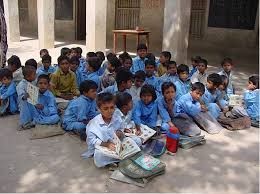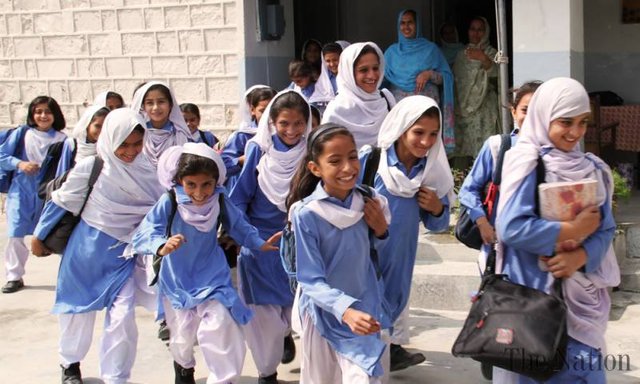Education in Pakistan
Education in Pakistan is overseen by the Federal Ministry of Education and the provincial governments, whereas the federal government mostly assists in curriculum development, accreditation and in the financing of research and development. Article 25-A of Constitution of Pakistan obligates the state to provide free and compulsory quality education to children of the age group 5 to 16 years. "The State shall provide free and compulsory education to all children of the age of five to sixteen years in such a manner as may be determined by law".[3]
The education system in Pakistan[4] is generally divided into six levels: preschool (for the age from 3 to 5 years), primary (grades one through five), middle (grades six through eight), high (grades nine and ten, leading to the Secondary School Certificate or SSC), intermediate (grades eleven and twelve, leading to a Higher Secondary School Certificate or HSSC), and university programs leading to undergraduate and graduate degrees.[5]
The literacy rate ranges from 96% in Islamabad to 28% in the Kohlu District.[6] Between 2000 and 2004, Pakistanis in the age group 55–64 had a literacy rate of almost 38%, those ages 45–54 had a literacy rate of nearly 46%, those 25–34 had a literacy rate of 57%, and those ages 15–24 had a literacy rate of 72%.[7] Literacy rates vary regionally, particularly by sex. In tribal areas female literacy is 9.5%.[8] Moreover, English is fast spreading in Pakistan, with more than 92 million Pakistanis (49% of the population) having a command over the English language,[9] which makes it one of the top English-speaking nations in the world. On top of that, Pakistan produces about 445,000 university graduates and 10,000 computer science graduates per year.[10] Despite these statistics, Pakistan still has one of the highest illiteracy rates in the world[11] and the second largest out of school population (5.1 million children) after Nigeria.[12]

Contents [hide]
1 Stages of formal education
1.1 Primary education
1.2 Secondary education
1.3 Tertiary education
1.4 Quaternary education
1.5 Nonformal and informal education
2 Gender disparity
3 Qualitative dimension
4 Achievements
4.1 International praise
4.2 Abdus Salam
4.3 Ayub Ommaya
4.4 Mahbub-ul-Haq
4.5 Atta-ur-Rahman
5 Education expenditure as percentage of GDP
6 University rankings
7 Religion and education
8 Literacy rate
8.1 School attendance
8.1.1 Youth literacy rate
9 International education
10 See also
11 References
12 Further reading
13 External links
Stages of formal education[edit]
Primary education[edit]
Children sitting and standing in a room
A primary school in a village in the Sindh region
Only 87% of Pakistani children finish primary school education.[13] The standard national system of education is mainly inspired from the British system. Pre-school education is designed for 3–5 years old and usually consists of three stages: Play Group, Nursery and Kindergarten (also called 'KG' or 'Prep'). After pre-school education, students go through junior school from grades 1 to 5. This is followed by middle school from grades 6 to 8. At middle school, single-sex education is usually preferred by the community, but co-education is also common in urban cities. The curriculum is usually subject to the institution. The eight commonly examined disciplines are Urdu, English, mathematics, arts, science, social studies, Islamic studies and sometimes computer studies (subject to availability of a computer laboratory). Provincial and regional languages such as Punjabi, Sindhi, Pashto and others may be taught in their respective provinces, particularly in language-medium schools. Some institutes give instruction in foreign languages such as Turkish, Arabic, Persian, French and Chinese. The language of instruction depends on the nature of the institution itself, whether it is an English-medium school or an Urdu-medium school.
As of 2009, Pakistan faces a net primary school attendance rate for both sexes of 66 percent: a figure below estimated world average of 90 percent.[14]
Pakistan's poor performance in the education sector is mainly caused by the low level of public investment. Public expenditure on education has been 2.2 percent of GNP in recent years, a marginal increase from 2 percent before 1984-85. In addition, the allocation of government funds is skewed towards higher education, allowing the upper income class to reap majority of the benefits of public subsidy on education. Lower education institutes such as primary schools suffer under such conditions as the lower income classes are unable to enjoy subsidies and quality education. As a result, Pakistan has one of the lowest rates of literacy in the world and the lowest among countries of comparative resources and socio-economic
